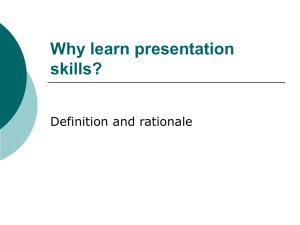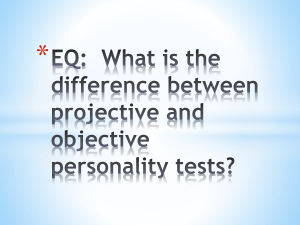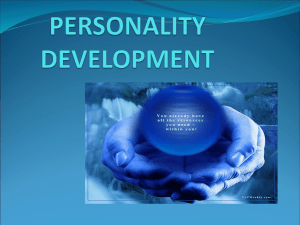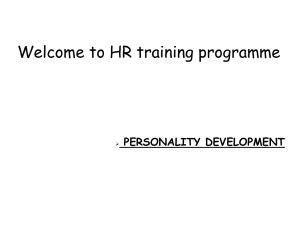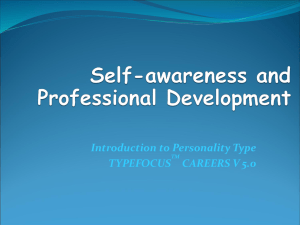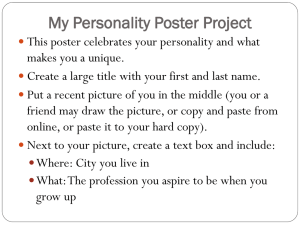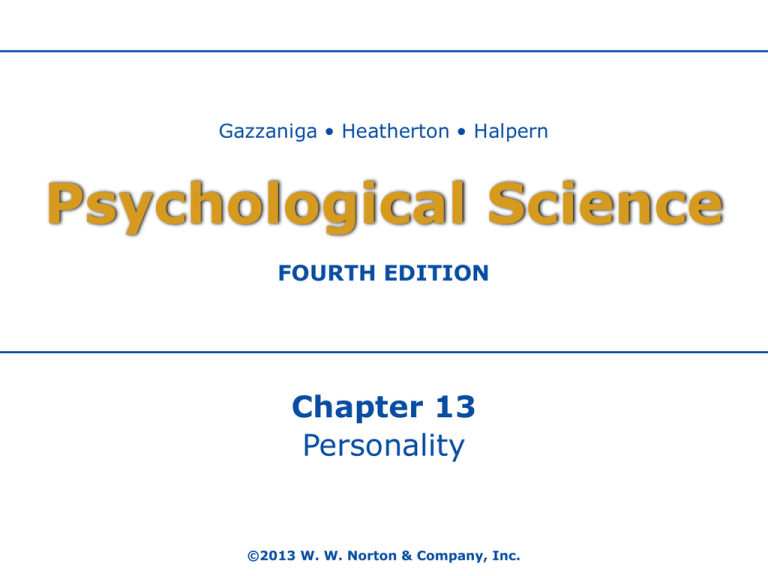
Gazzaniga • Heatherton • Halpern
Psychological Science
FOURTH EDITION
Chapter 13
Personality
©2013 W. W. Norton & Company, Inc.
13.1 How Have Psychologists
Studied Personality?
• Describe the major approaches to the study of
personality.
• Identify theorists associated with the major
approaches to the study of personality.
• Define key terms associated with the major
approaches to the study of personality.
How Have Psychologists
Studied Personality?
• Personality: the characteristic thoughts, emotional
responses, and behaviors that are relatively stable in
an individual over time and across circumstances
• Personality psychologists explore the influence of
culture, learning, biology, and cognition on the
development of personality traits
• Personality trait: a characteristic; a dispositional
tendency to act in a certain way over time and across
circumstances
• Contemporary psychologists are primarily interested
in trait approaches and the biological basis of
personality traits
Psychodynamic Theories Emphasize
Unconscious and Dynamic Processes
• Freud developed many ideas about personality
by observing his patients
• He believed their problems were psychogenic:
caused by psychological rather than physical
factors
• Psychodynamic theory: Unconscious forces—
wishes, desires, hidden memories—determine
behavior
Unconscious Conflicts
• Freud believed that our conscious awareness was only a small
fraction of our mental activity and that most mental processes
are unconscious
• Levels of awareness:
– Conscious: thoughts that we are aware of
– Preconscious: content that is not currently in awareness but that
could be brought to awareness
– Unconscious: contains material that the mind cannot easily
retrieve
• Hidden memories, wishes, desires, and motives are often in
conflict, which produces anxiety/psychological discomfort
• To protect us from this distress, these forces and their conflicts
are not accessible; sometimes, however, this information leaks
into consciousness
A Structural Model of Personality
• Personality consists of three interacting structures that
vary in their access to consciousness:
– Id: completely submerged in the unconscious; operates
according to the pleasure principle, which is powered by libido
– Superego: internalized societal and parental standards of
conduct
– Ego: tries to satisfy the wishes of the id while being responsive
to the dictates of the superego; operates according to the
reality principle
• Conflicts between the id and the superego lead to
anxiety
• The ego then copes through various defense
mechanisms
Psychosexual Development
• Early childhood experiences have a major impact on the
development of personality
• Children go through developmental stages that correspond to
the different libidinal urges:
– Oral: birth to 18 months. Infants seek pleasure through the
mouth
– Anal: 2-3 years. Learning to control the bowels leads to a focus
on the anus
– Phallic stage: 3-5 years. Focus is on the genitals; Oedipus complex
– Latency stage: Children suppress libidinal urges
– Genital stage: adolescence/adulthood. Libidinal urges focused on
the capacities to reproduce and to contribute to society
• Some people become fixated at a stage
Psychodynamic Theory Since Freud
• A number of influential scholars modified Freud’s
ideas in their own psychodynamic theories
• Neo-Freudians: Carl Jung, Alfred Adler, Karen
Horney
• Contemporary neo-Freudians focus on social
interactions, especially children’s emotional
attachments to their parents or primary
caregivers (object relations)
Humanistic Approaches Emphasize
Integrated Personal Experience
• Humanistic approaches: emphasize personal experience,
belief systems, the uniqueness of the human condition,
and the inherent goodness of each person
• Self-actualization: People seek to fulfill their potential for
personal growth through greater self-understanding
• Carl Rogers’ person-centered approach emphasized the
importance of people’s subjective understandings of their
lives
• Encouraged parents to raise their children with
unconditional positive regard so that they might become
fully-functioning people
Personality Reflects
Learning and Cognition
• George Kelly’s (1955) personal constructs: People have
personal theories of how the world works
• Julian Rotter’s (1954) expectancy-value approach:
Internal/external locus of control
• Cognitive-social theories of personality: emphasize how
personal beliefs, expectancies, and interpretations of
social situations shape behavior and personality
• Mischel’s cognitive-affective personality system (CAPS)
– Defensive pessimism: people expect to fail
– Self-regulatory capacities: ability to set personal goals,
evaluate, progress, and adjust behavior accordingly
Trait Approaches
Describe Behavioral Dispositions
• Personality types: discrete categories of people
based on personality characteristics
– Implicit personality theories: We assume that
certain personality characteristics go together;
we make predictions about people based on
minimal evidence
• Trait approach: focuses on how individuals differ in
personality dispositions, such as sociability,
cheerfulness, and aggressiveness
• Cattell’s (1965) factor analysis identified 16 basic
dimensions of personality
“Enjoying Aggression”
Is aggressive behavior something that sometimes happens just
because we like it? As this ScienCentral News report explains,
research done on mice suggests we enjoy aggression the same
way we enjoy other addictive activities.
Eysenck’s Hierarchical Model
• Hans Eysenck proposed a hierarchical model of
personality
• The basic structure of this model included:
– Specific response level
– Habitual response level
• Superordinate traits
– Introversion/extraversion
– Emotional stability
– Psychoticism
The Big Five
• Five-factor theory: identifies five basic personality
traits (McCrae & Costa, 1999)
– The “Big Five”: openness to experience,
conscientiousness, extraversion, agreeableness, and
neuroticism
– For each factor, there is a continuum from low to high.
Each factor is a higher-order trait that is made up of
interrelated lower-order traits
– People’s “scores” on the Big Five traits have been
shown to predict a wide variety of different behaviors
(e.g., conscientiousness predicts grades in college)
• The Big Five approach currently dominates how
many psychologists study personality
13.2 How Is Personality Assessed,
and What Does It Predict about People?
• Distinguish between idiographic and nomothetic approaches
to the study of personality.
• Distinguish between projective and objective measures of
personality.
• Discuss the accuracy of observers’ personality judgments.
• Define situationism and interactionism.
• Distinguish between strong situations and weak situations.
• Discuss cultural and sex differences in personality.
How Is Personality Assessed,
and What Does It Predict about People?
• Personality researchers do not agree on the best
method for assessing personality
• Psychologists measure personality by having people
report on themselves, by asking people’s friends or
relatives to describe them, or by watching how
people behave
• Each method has strengths and limitations
Personality Refers to Both Unique
and Common Characteristics
• Gordon Allport divided the study of personality into two
approaches:
• Idiographic approaches: person-centered approaches to
studying personality. Focus is on individual lives and how
various characteristics are integrated into unique persons.
– Henry Murray tried to account for Adolf Hitler’s behavior in Nazi
Germany by studying Hitler’s early childhood experiences, his
physical stature, and his personal motivations
• Nomothetic approaches: study of personality that focuses on
how common characteristics vary from person to person
– The five-factor theory looks at how all people vary on five basic
personality traits
Researchers Use
Projective and Objective Methods
to Assess Personality
• Researchers use numerous methods to assess personality
ranging from observer reports to self-reports to clinical
interviews
• The way researchers choose to measure personality
depends to a great extent on their own theoretical
orientations (e.g., trait researchers vs. humanistic
psychologists)
• Assessment procedures can be grouped into projective
measures and objective measures
Projective Measures
• Projective measures: personality tests that
examine unconscious processes by having people
interpret ambiguous stimuli
• The general idea is that people will reveal hidden
aspects of personality such as motives, wishes,
and unconscious conflicts
• Rorschach inkblot test
• Thematic Apperception Test (TAT)
Objective Measures
• Objective measures: relatively direct assessments of
personality, usually based on information gathered through
self-report questionnaires or observer ratings
• A questionnaire might target a specific trait, such as how
much excitement a person seeks out of life (e.g., sensation
seeking)
• More often, an objective measure will include a large
inventory of traits:
– NEO Personality Inventory consists of 240 items, which are
designed to assess the Big Five personality factors.
– California Q-Sort: Participants are given 100 cards with
statements printed on them. They then sort the cards into nine
piles according to how accurately the statements describe them.
Observers Show Accuracy
in Trait Judgments
• How well do observers’ personality judgments predict others’
behavior?
• Funder (1995) found a surprising degree of accuracy for trait
judgments under certain circumstances (e.g., a person’s close
acquaintances may predict the person’s behavior more accurately
than the person does)
• Simine Vazire (2010) compared the accuracy of people’s selfjudgments with the accuracy of how their friends describe them
– The comparative accuracy depends on whether the traits are
observable and whether the people being rated are motivated to
view themselves positively on the traits
People Sometimes Are Inconsistent
• Situationism: the theory that behavior is determined more
by situations than by personality traits (Mischel, 1968)
• Mischel’s critique of personality traits caused considerable
rifts between social psychologists, who emphasize
situational forces, and personality psychologists, who focus
on individual dispositions
• The vigorous response to Mischel’s critique has come to be
called the person/situation debate
– Personality researchers argued that how much a trait predicts
behavior depends on three factors: the centrality of the trait, the
aggregation of behaviors over time, and the type of trait being
evaluated
Behavior Is Influenced by the
Interaction of Personality and Situation
• Most trait theorists are interactionists. They believe
that behavior is determined jointly by situations and
underlying dispositions.
• A reciprocal interaction occurs between the person
and the social environment so that they
simultaneously influence each other.
• Personality reflects a person’s underlying disposition,
the activation of the person’s goals in a particular
situation, and the activation of the person’s
emotional responses in the pursuit of those goals.
There Are Cultural and Sex Differences
in Personality
• Schmitt, Allik, McCrae, & Benet-Martinez, (2007) investigated
personality differences across 56 nations
• They found that the Big Five personality traits are valid
across all the countries, with modest differences across
them
• Research findings have made clear that self-reports often do
not match cultural stereotypes about the respondents
• Women and men are more similar than different, but the
differences between them largely support the stereotypes
• Sex differences in personality are largest in North America and
Europe and smallest in Asian and African communities
13.3 What Are the Biological Bases
of Personality?
• Review research assessing personality traits among
nonhuman animals.
• Summarize the results of twin studies and adoption studies
as those results pertain to personality.
• Identify the genetic basis of novelty seeking, neuroticism,
and agreeableness.
• Identify distinct temperaments.
• Discuss the neurobiological basis of
extraversion/introversion.
• Summarize the results of research on personality stability
across time.
What Are the Biological Bases
of Personality?
• Genes, brain structures, and neurochemistry play
an important role in determining personality
• Genetic makeup may predispose certain traits or
characteristics, but whether these genes are
expressed depends on the unique circumstances
that people face during their development
“Generosity Hormone”
Scientists have found that a hormone makes people more
generous. As this ScienCentral News video explains, it’s a
brain hormone, and it even makes people more generous to
strangers.
Animals Have Personalities
• Animals, across circumstances, might display consistent
individual differences in behaviors, and those individual
differences might reflect underlying biological bases of
personality (Gosling, 2001)
• Findings of 19 studies that assessed multiple personality traits
in nonhuman animals (e.g., from household pets to chimps)
found evidence of traits similar to extraversion, neuroticism,
and agreeableness in most species; only chimpanzees showed
any signs of conscientiousness (Gosling & John, 1999)
• Dogs’ personalities can be rated with impressive accuracy
“Monkeys Show Their Generous Side”
The idea that “it’s better to give than receive” may not be
limited to humans. Now, as this ScienCentral News video
explains, researchers have found a group of monkeys that seem
to get pleasure from giving.
“Dog Personality”
Do canines have character? As this ScienCentral News video
reports, according to one psychologist, personality testing is
going to the dogs.
Personality Is Rooted in Genetics
• There is overwhelming evidence that nearly all
personality traits have a genetic component
(Plomin & Caspi, 1999)
• Across a wide variety of traits, identical twins are
much more similar than fraternal twins
• Identical twins receive more-similar treatment
than other siblings, and that treatment can
explain some of the similarity in personality
Adoption Studies
• Children who are not biologically related and who are
raised in the same household as adopted siblings tend to
be no more alike in personality than any two strangers
• Personalities of adopted children bear no significant
relationship to those of the adoptive parents
• Findings suggest that parenting style may have relatively
little impact on personality
• Similarities in personality between biological siblings and
between children and their biological parents seem to
have some genetic component
Are There Specific Genes
For Personality?
• Genes predispose us to have certain personality traits
associated with behavioral tendencies
• In most cases, researchers note the influence of multiple
genes that interact independently with the individual’s
environment to produce general dispositions
• Evidence suggests that genes can be linked with some
specificity to personality traits.
– Example: A gene that regulates one particular dopamine receptor
has been associated with novelty seeking (Cloninger, Adolfsson, &
Svrakic, 1996; Ekelund, Lichtermann, Jaervelin, & Peltonen, 1999)
Temperaments Are Evident in Infancy
• Genes help produce biological differences in
personality called temperaments
• Temperaments are general tendencies to feel or act
in certain ways; they represent the innate biological
structures of personality
• Three personality characteristics considered as
temperaments:
– Activity level: overall amount of energy and behavior a
person exhibits
– Emotionality: intensity of emotional reactions
– Sociability: general tendency to affiliate with others
“Wild Young Brains”
Are violence and aggression genetic or a response to upbringing?
As this ScienCentral News video reports, psychologists say the
answer is both—but parenting can shape the effects of children’s
genes.
Long-Term Implications
of Temperaments
• Early childhood temperaments significantly influence behavior
and personality structure throughout a person’s development
(Caspi, 2000)
• Researchers investigated the health, development, and
personalities of more than 1,000 people born during a particular
period; individuals were examined approximately every two
years, with 97 percent remaining in the study through their 21st
birthdays
• At 3 years of age, they were classified into temperamental types
based on examiners’ ratings
• The classification at age 3 predicted personality structure and a
variety of behaviors in early adulthood
Personality Is Linked to
Specific Neurophysiological Mechanisms
• Temperaments affect how the child responds to and
shapes her or his environment; in turn, the child’s
environment and temperament interact to shape the
child’s personality
• Differences between personalities may reflect differences
in the relative activation of different biological systems
(Canli, 2006)
• Most research on the neurobiological underpinnings of
personality has explored the dimension of
extraversion/introversion
Arousal and Extraversion/ Introversion
• Eysenck believed that differences in cortical arousal
produce the behavioral differences between extraverts
and introverts
• Cortical arousal, or alertness, is regulated by the
ascending reticular activating system (ARAS)
• Eysenck proposed that the system of reticular activation
differs between extraverts and introverts, with the
resting levels of the ARAS higher for introverts than for
extraverts
– The visible biological difference between introverts and
extraverts appears to be their level of arousability, or how
much they react to stimuli
– Introverts are more arousable
Behavioral Activation and Inhibition Systems
• Gray (1987) proposed that personality is rooted in two
motivational functions: the behavioral approach system and the
behavioral inhibition system:
– Behavioral approach system (BAS): consists of the brain
structures that lead organisms to approach stimuli in pursuit of
rewards; this is the “go” system
– Behavioral inhibition system (BIS): Because it is sensitive to
punishment, the BIS inhibits behavior that might lead to danger
or pain; this is the “stop” system
– Extraverts have a stronger BAS than BIS, which means
extraverts are more influenced by rewards than by
punishments
• Imaging research shows that each of the Big Five personality traits
is associated with different brain regions (DeYoung et al., 2010)
Personality Is Adaptive
• From an evolutionary standpoint, personality traits useful for
survival and reproduction may have been favored:
– Being competitive has enabled individuals to obtain great
rewards or to enjoy increased value in their social groups
– Traits provide important information about desirable and
undesirable qualities in mates
• Another possible explanation for individual differences is related
to the skills possessed by members of groups
• Groups whose members possess diverse skills (e.g., novelty
seekers versus more cautious members) have a selective
advantage over groups whose members have a limited number
of skills (Caporael, 2001)
Personality Traits Are Stable over Time
• How much can/do people change over time?
• Continuity over time and across situations is
inherent in the definition of trait, and most
research finds personality traits to be remarkably
stable over the adult life span (Heatherton &
Weinberger, 1994)
• Research suggests that personality changes
somewhat in childhood but becomes more stable
by middle age
Age-Related Change
• With age, people become less neurotic, less
extraverted, and less open to new experiences;
they also tend to become more agreeable and
more conscientious (Srivastava, John, Gosling, &
Potter, 2003)
• Age-related changes in personality occur
independently of environmental influences;
therefore that personality change may be based in
human physiology
Characteristic Adaptations
• Basic tendencies are dispositional traits determined
largely by biological processes; they are very stable
• Characteristic adaptations are adjustments to
situational demands; they tend to be somewhat
consistent because they are based on skills, habits,
roles, etc.
• Overall, personality appears to be relatively stable,
especially among adults, with stability of situations
likely contributing to the stability of personality
“Set in Your Ways”
Contrary to popular belief, your personality may not be set in
stone by the time you’re thirty. As this ScienCentral News video
reports, a survey shows some traits that may keep changing in
later years.
13.4 How Do We Know
Our Own Personalities?
• Differentiate between self awareness, self-schema, the
working self-concept, and self-esteem.
• Review theories of self-esteem.
• Discuss research findings regarding the association
between self-esteem and life outcomes.
• Identify strategies people use to maintain positive selfviews.
• Discuss cultural differences in the self-concept and the
use of self-serving biases.
How Do We Know
Our Own Personalities?
• Each of us has a notion of something we call the
“self”
• The sense of self involves:
– mental representations of personal experiences
(memories and perceptions)
– a sense of one’s physical body
– a conscious awareness of being separate from others
and unique
• This sense of self is a unitary experience,
continuous over time and space
Our Self-Concepts
Consist of Self-Knowledge
• Your self-concept is everything you know about yourself
• Many psychologists view the self-concept as a cognitive
knowledge structure that guides a person’s attention to
relevant information and helps them adjust to their
environment
• Example: If you think of yourself as shy, you might avoid a
raucous party. If you believe yourself to be optimistic,
you might easily bounce back from a poor grade in
organic chemistry.
Self-Awareness
• James and Mead differentiated between the self as the
knower (“I”) and the self as the object that is known
(“me”)
• Psychologists now call the self that is known the
objectified self, which is the knowledge the subject holds
about itself
• The sense of self as the object of attention is the
psychological state known as self-awareness
– Duval and Wicklund’s theory of objective self-awareness
– Higgins’s self-discrepancy theory
• Self-awareness depends on normal development of the
frontal lobes
Self-Schema
• Each person processes information about himself or
herself deeply, thoroughly, and automatically
• Self-schema: The cognitive aspect of the selfconcept; A network of interconnected knowledge
about the self
– Self-schema help us filter, perceive, organize,
interpret, and use information about the self
• The brain: When people process information about
themselves, there is activity in the middle of the
frontal lobes; The greater the activation of this area
during the self-referencing, the more likely the
person is to remember the item later during a
surprise memory task
Working Self-Concept
• Psychologists refer to the immediate experience
of the self as the working self-concept
• Self-descriptions vary depending on which
memories you retrieve, which situation you are
in, which people you are with, and your role in
that situation
• When people consider who they are or think
about different features of their personalities,
they often emphasize characteristics that make
them distinct from others
Perceived Social Regard
Influences Self-Esteem
• Self-esteem is the evaluative aspect of the selfconcept
– People can objectively believe positive things about
themselves without liking themselves very much;
people can have high self-esteem, even when
objective indicators do not support such positive selfviews
• Reflected appraisal: Self-esteem is based on how
we believe others perceive us
– People internalize the values and beliefs expressed by
important people in their lives; they adopt those
attitudes (and related behaviors) as their own
Sociometer Theory
• Leary and colleagues (1995) propose that self-esteem is a
mechanism for monitoring the likelihood of social exclusion
• Humans have a fundamental, adaptive need to belong: Those who
belong to social groups are more likely to survive and reproduce
than those who are excluded and left to survive on their own
• Self-esteem is a sociometer, an internal monitor of social
acceptance or rejection
– When people behave in ways that increase the likelihood that they
will be rejected, they experience a reduction in self-esteem
– If probability of rejection remains low, the person will probably not
worry about how he or she is perceived by others
Self-Esteem and Death Anxiety
• Terror management theory: Self-esteem gives meaning
to people’s lives, protects them from the horror
associated with knowing they eventually will die
• People counter their fears of mortality by creating a
sense of symbolic immortality through contributing to
their culture and upholding its values
• Research has demonstrated that reminding people of
their mortality leads them to act in ways that enhance
their self-esteem (Goldenberg, McCoy, Pyszczynski,
Greenberg, & Solomon, 2000)
“Real Worries”
We may have nothing to fear but fear itself. But, as this
ScienCentral News video reports, even that can be deadly.
Self-Esteem and Life Outcomes
• Having high self-esteem seems to make people happier, but
it does not necessarily lead to successful social
relationships or life success
• Downsides to having very high self-esteem:
– Violent criminals and bullies commonly have high self-esteem
– When people with high self-esteem believe their abilities have
been challenged, they may act in ways that cause other people to
dislike them
• A personality trait associated with inflated self-esteem is
narcissism
• Because narcissists’ greatest love is for the self, they tend
to have poor relations with others (Campbell, Bush,
Brunell, & Shelton, 2005)
We Use Mental Strategies
to Maintain Our Views of Self
• Most people show favoritism to anything associated with
themselves
• Example: A study showed people prefer the letters of their own
names, especially their initials, to other letters (Koole,
Dijksterhuis, & van Knippenberg, 2001)
• Sometimes these positive views of the self seem inflated:
– When the College Entrance Examination Board surveyed more
than 800,000 college-bound seniors, not a single senior rated
herself or himself as below average, whereas a whopping 25
percent rated themselves in the top 1 percent (Gilovich, 1991)
• This phenomenon is known as the better-than-average effect
Self-Evaluative Maintenance
• Self-esteem can be affected by how people perform, how
relevant their performances are to their self-concepts, and
how their performances compare with those of significant
people around them
• Theory of self-evaluative maintenance: People can feel
threatened when someone close to them outperforms them
on a task that is personally relevant
• Self-evaluative maintenance causes people to exaggerate or
publicize their connections to winners and to minimize or hide
their relations to losers
Social Comparisons
• Social comparison: when people evaluate their
own actions, abilities, and beliefs by contrasting
them with other people’s
• People with high self-esteem tend to make
downward comparisons; people with low selfesteem tend to make upward comparisons
• People use a form of downward comparison
when they recall their own pasts: They often view
their current selves as better than their former
selves (Wilson & Ross, 2001)
Self-Serving Biases
• People with high self-esteem tend to take credit
for success but blame failure on outside factors
• Self-serving bias: the tendency for people to take
personal credit for success but blame failure on
external factors
• We are extremely well-equipped to protect our
positive beliefs about ourselves, with some
researchers arguing that self-serving biases
reflect healthy psychological functioning
“Feeling Good and Grades”
When it comes to education, which comes first, the chicken or
the egg? As this ScienCentral News video reports, education
researchers are questioning whether high self-esteem brings
academic success or the other way around.
There Are
Cultural Differences in the Self
• An important way in which people differ in self-concept is
whether they view themselves as fundamentally separate
from or connected to other people
• Collectivist cultures emphasize connections to family, to
social groups, and to ethnic groups; conformity to societal
norms; and group cohesiveness
• Individualist cultures emphasize rights and freedoms,
self-expression, and diversity
• People in collectivist cultures have interdependent selfconstruals
• People in individualist cultures have independent selfconstruals
Culture and Self-Serving Bias
• There has been a lively debate among psychologists
concerning the question of whether self-serving bias is
universal
• Some suggest that self-enhancement may be as much a
part of human nature as eating
• Heine and colleagues (1999) have argued, however, that
the self-serving bias may be more common in Western
cultures than in Eastern cultures
• Western cultures emphasize individuality. Believing that
someone is an especially talented individual presupposes
that some people are better than others, which is an
attitude that is not acceptable in Eastern cultures


